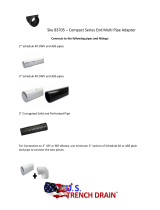Page is loading ...

Air Admittance Valves (AAVs)
FAQs
Q What is the denition of DWV?
A DWV is an acronym used in the plumbing industry which means Drainage, Waste and Vents.
Q What is the denition of an AAV and what is it used for?
A AAV = Air Admittance Valve. The AAV is designed to take the place of a xture or branch vent.
Q Can an Oatey Sure-Vent be installed outside?
A No. The Sure-Vents are not designed for exposure to Ultra Violet Rays.
Q Can the Sure-Vent be used in place of a main vent stack?
A No. Every dwelling needs to have one main vent stack exiting the rooine into the free atmosphere. It is
also recommended that a relief vent be installed when completing a new home or large addition rough-in.
Q Does the Sure-Vent require maintenance?
A Yes. The Sure-Vent is a mechanical device and like all mechanical devices, a scheduled maintenance
routine should be set up to ensure AAV is functioning properly.
Q How high above the xture trap should the Sure-Vent be located?
A A minimum of four inches above the horizontal branch drain (trap).
Q Can the Sure-Vent be used to vent a sealed sump pit with waste grinder pump?
A Yes, with exceptions. Always check with your local building ofcials to conrm this application is approved in
your municipality before attempting this installation. We also recommend you check with the pump manufacturer
before completing installation. Remember, you also need to vent any xture or group of xtures, and check with
your local building ofcial to ensure your plumbing system is designed properly before installation. If they are not
vented properly, the drains will not ow properly. After conrming all parties involved approve this application,
contact our customer service department who will send out a drawing explaining the application.

FAQs
Q What is a DFU?
A DFU stands for drainage xture unit. This is a measure of probable uid discharge into the drainage system
by various types of plumbing xtures. Each xture’s DFU value depends on the volume of uid discharge
per cycle and an average time between cycles. The chart below gives you some examples of xture DFU
calculations. Always check with local building of cials to conrm these calculations match theirs.
• Private Toilets (1.6 gpf) – 3 DFUs • Shower (5.7 gpm or less) – 2 DFUs
• Public Toilets (1.6 gpf) – 4 DFUs • Kitchen Sink (domestic) with food grinder or dishwasher – 2 DFUs
• Urinals (1 gpf or less) – 2 DFUs • Laundry Sinks (1 or 2 compartments) – 2 DFUs
• Res. washing machine – 2 DFUs • Commercial washing machine – 3 DFUs
• Bathtub with or without overhead shower or whirlpool attachments – 2 DFUs
• Bathroom Group – 5 DFUs: consisting of 1-toilet (1.6 gpf), 1-lavatory sink, 1-bathtub or shower, including or
excluding 1-bidet and 1-emergency oor drain. All xtures in this group must be located on the same level.
Q Can the Sure-Vent be installed inside a closed wall?
A No. The AAV must have access to the open atmosphere. If the Sur-Vent is to be installed in a wall cavity,
you must use one of our AAV wall boxes with a louvered face plate. This allows the Sure-Vent to have
access to the open atmosphere, and also acts as an access door.
Q Can the Sure-Vent be installed in the attic?
A Yes, with exceptions. The attic has certain conditions that can affect the AAV performance which should
be considered before choosing this as a location. The temperature ranges that the Sure-Vent will operate
in are -40°F to 150°F, your attic can experience drastic temperature variations depending on how it is
vented and your geographic location. Insulation bers can get caught inside the diaphragm which will
make it harder for the diaphragm to open, or achieve a good seal when it is in the closed position. The
Sure-Vent should be installed a minimum of six inches above the nished height of your insulation, and
the attic must have an access point to conduct scheduled maintenance.
Q Does Oatey Sure-Vent come in different sizes?
A Sure-Vents come in 6 DFU capacity, 20 DFU capacity, 160 DFU capacity and 500DFU capacity.
Air Admittance Valves (AAVs)

Q What xtures can the Sure-Vent be used to vent?
A You must rst check with your local building ofcials to conrm that the Sure-Vent installation you are
attempting is recognized as an approved application. If your application is approved under the guidelines of
the plumbing code in your area, a Sure-Vent can be used to vent any plumbing xture and or oor drain.
Q Is the Sure-vent approved for use in a RV?
A Yes, with exceptions. When the RV is stationary, the Sure-Vent will properly vent the drains for the
kitchen and bathroom. If the RV is in motion and depending on how the DWV system was assembled
from the factory, positive pressure could stop the Sure-Vent from opening.
Q Can AAVs be installed if the home has a septic system and not city sewer services?
A Yes, with exceptions. Remember that septic systems build up positive pressure as the organic waste
breaks down in the tank, this creates positive pressure. This positive pressure can affect the performance
of the Sure-Vent, and you may have to add a vent on the inlet side of the septic tank if this happens. The
vent on the septic tank is most commonly recognized as a pipe that looks like a candy cane.
Q What is the difference between positive and negative pressure, how does it affect the Sure-Vent?
A Negative pressure in a DWV is created when a drain or xture has uids owing through them, this is
why a vent is required. Without a vent the water would ow very slowly or not at all. Example: stick a
straw in a glass of water and before you remove the straw, put you thumb over the top of the straw.
When you remove the straw, the water stays in the straw because there is no vent. When you remove
your thumb, the water ows out of the straw because you have a vent. The Sure-Vent allows each
plumbing xture and drain to receive the needed air to drain properly. Positive pressure is present when
the city sewers are relieving pressure that is designed to push back up through the building sewer and
eventually out of the roof vent on your home or building. While this positive pressure is being released
and your plumbing xtures and or drains are not being used, the Sur-Vent will remain closed. This is
important because if the Sure-Vent did not protect you from positive pressure, your home would ll up
with foul odors.
FAQs
Air Admittance Valves (AAVs)

FAQs
Air Admittance Valves (AAVs)
Q Can the Sure-Vent be installed horizontally?
A No. Sure-Vent must be installed as close to vertical as possible. You cannot have the Sure-Vent tilted
more than 15° from side to side, otherwise it will not operate properly.
Q Can the AAV malfunction and what are the signs?
A Yes. Any AAV can malfunction or not operate properly because it is a mechanical device. Signs of that
the Sure-Vent is not operating as intended, are foul odors. If you smell foul odors (sewer smell) near a
plumbing xture which has a Sure-Vent installed, this means the Sure-Vent is not closing properly to
create a positive seal and should be replaced. Some individuals relate slow drains to the Sure-Vent not
operating properly. The Sure-Vent is not the issue, the slow drain is related to a partial blockage within
the drain itself. A partially blocked drain will ll with water when the xture is draining, and the Sure-Vent
recognizes the positive pressure from the restriction and stays in closed position to stop backow out of
the Sure-Vent. You should have your drain cleaned when this occurs.
/



